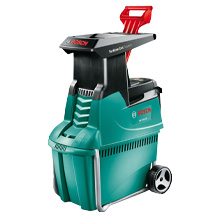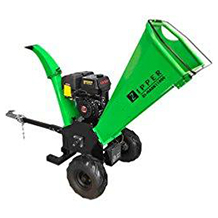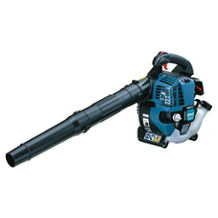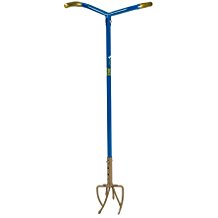Lawn spreader purchasing advice: how to choose the right product
- The most important facts in brief
- Lawn spreaders are used for the even distribution of all types of grit.
- Depending on your needs, a lawn spreader can prove to be quite useful in all seasons.
- Buyers can choose between classic lawn spreaders, hand spreaders, centrifugal spreaders and models for the lawn mower tractor.
- Although the operation itself is not complicated, various functions improve the spreading result.
Spreading grit, seed and fertiliser evenly
A lawn spreader is used in various fields. Typically, it is used in horticulture and winter maintenance, but it can also be found as a useful accessory in private gardens. It spreads fertiliser, seeds, road salt, grit and other material of comparable diameter evenly.
The history of spreaders
For many centuries since becoming sedentary, people have spread grit by hand. When animal-drawn carts came along, they also used them to spread manure in the fields. However, at first there was no mechanism to spread the material. Therefore, helpers stood on the wagons and used additional tools to spread the material.
Gradually, the animals were replaced by motors and the mechanical spreader was created. Finally, the handy small devices appeared that work both with and without a motor. Even if there is no motor, the models often have an automatic mechanism that regulates the spreading. This ensures that the device spreads the material constantly over a distance.
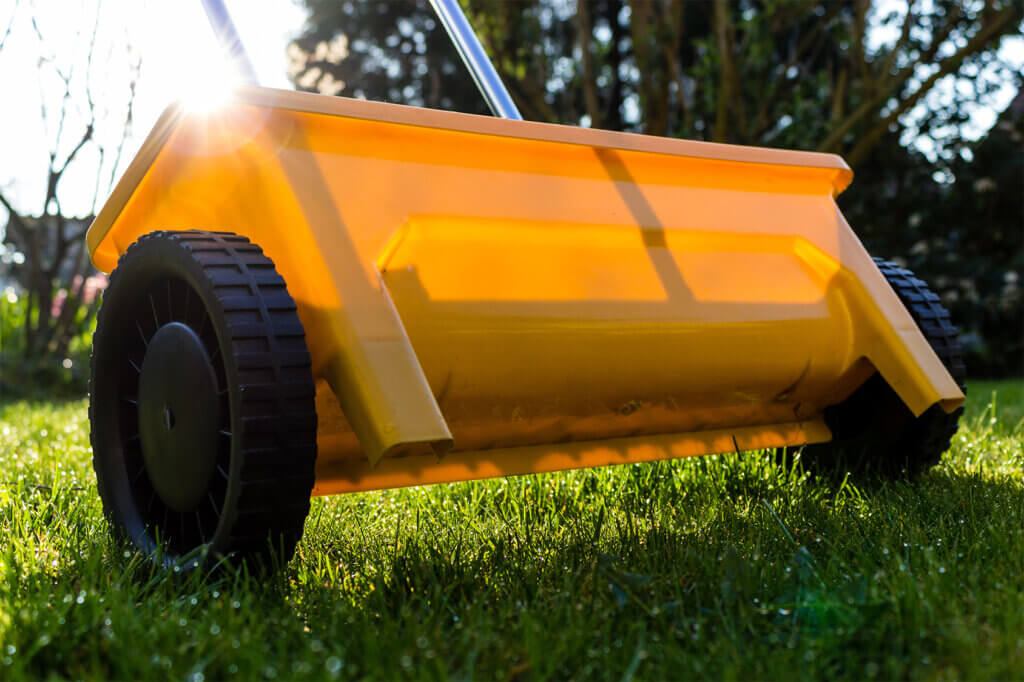
Why is it worth buying a lawn spreader?
For whom is it worth buying a lawn spreader? Of course, the work can also be done by hand. However, problems quickly arise here. For example, dosing by hand is much less accurate than with a specialised machine. Unevenly applied road salt, on the other hand, does not guarantee a completely ice-free and sure-footed surface.
When sowing, even distribution is also important, because areas that are sown too loosely provide space for undesirable weeds. Areas sown too densely, on the other hand, exert too much stress on the individual plants, so that all seedlings remain below their growth potential. Ultimately, the seed cannot emerge as desired.
Thanks to the spreader trolley and its neat distribution method, such problems occur only to a small extent. Another advantage of the device over manual labour is that users do not have to carry as much spreading material. Because they have to fetch supplies less often, they are finished correspondingly faster.
The types at a glance
In addition to the classic lawn spreaders, there are also particularly handy devices, special centrifugal spreaders and trailing spreaders for attaching to a lawn tractor.
Classic lawn spreaders
The simple models are considerably cheaper than those with a special mechanism, such as centrifugal spreaders. Consumers cannot go far wrong with such a device. Before spreading, all they have to do is fill the hopper and then pull the device over the desired area. The spreading material trickles out on the spot, and the spreading width is limited. The containers are sufficient for small to medium sized areas.
Advantages
- Inexpensive
- Simple operation
- Low susceptibility to breakdowns
- Sufficient for many private areas
- Space-saving
Disadvantages
- Little comfort
- Unsuitable for large areas
The areas of application: Where are the classics worthwhile?
Due to the limitation of the area size, these models are primarily interesting for private gardens and properties. With just a few steps, a medium-sized lawn can be sown or the pavement in front of the house treated with road salt. Due to their small size, they also fit into a small garden shed or garage. If there is not enough space, it is even possible to hang the lightweights on the wall.
Hand spreader: Spreading without wheels
The hand spreader is a particularly handy device. It has no tyres, as users carry it entirely with them during work. Typically, one hand holds the spreader while the other drives a mechanism to start spreading, for example by means of a crank.
Since the hand spreader is only suitable for carrying, the container size is only sufficient for smaller quantities of spreading material. However, the contents can be sufficient for areas of up to 100 square metres. Many products also allow practical settings so that comfort is not neglected. However, because users hold the handheld device in front of the body and operate it there, dust or coarser material can get onto clothing.
Advantages
- Handy
- Easy
- For small areas
- Often with adjustment possibilities
Disadvantages
- Too small for larger uses
- Can soil clothing
The areas of application: Where are the handy spreaders worthwhile?
Little storage space and infrequent need for grit – these are the two most common reasons why consumers opt for mini gritters. They are usually so small that they can easily be stored on a shelf or in a cupboard. Because they can be cleaned in any large sink or shower, they can even be taken into the house without contaminating it with grit. So if the garden is so small that there is no room for a garden shed, or if owners want to protect themselves better against theft, they are well equipped with these specimens.
Centrifugal or centrifugal spreaders
The technology inside these devices is more complex than in their alternatives. This makes them correspondingly more expensive. Centrifugal spreaders cost at least twice as much as classic lawn spreaders. The unusual design puts the spreading material into high velocity. As a result, the mechanism also spreads the material further. In the end, users save a lot of time because the spread strips are much wider than with ordinary lawn spreaders.
Advantages
- Suitable for large to very large areas
- Fast and precise spreading
- Easy to operate
- Many different hopper sizes available
Disadvantages
- High purchase price
- Too large for small areas
The areas of application: Where are the centrifugal lawn spreaders worthwhile?
First and foremost, the device is aimed at commercial users. Anyone who has a large property and needs to sprinkle it more frequently will find a centrifugal spreader to be the right product. This is the case, for example, on agricultural or commercial farms. It can also be used to quickly de-ice car parks. In addition, it should not be missing from the fleet of winter services and horticultural companies.
The trailed ones: lawn spreaders for lawn tractors
This variant is also known as a trailing spreader. Before use, drivers have to connect the device to the lawn tractor like a trailer. This is followed by filling it with the spreading material of choice; there are only a few restrictions here. Finally, individual settings allow the cart to be adjusted to the diameter of the spreading material.
During spreading, the units use centrifuges for wide-area distribution, as with the centrifugal spreader. The spreading width can often also be adjusted to the prevailing conditions of the target route. The drive is usually linked to the axle rotation, but some variants with hydraulic drive can also be found. Although it is not necessary to push the spreader by hand, some products allow this additional function.
Advantages
- Can be coupled to lawn tractors
- Partially also suitable for cars or manual operation
- Suitable hopper size for large areas or long distances
- No effort required for spreading
Disadvantages
- Very expensive
- High space requirement
- Time-consuming cleaning
The areas of application: Where are walk-behind spreaders worthwhile?
For the purchase to be worthwhile, buyers should already have a lawn tractor. Gardeners and landscapers often already have such machines in their fleet to carry out mowing work with. These lawn spreaders also have a positive effect on the tractors, because from now on they no longer have to stand around unused for months during the cold season.
No matter whether you are already sowing the first sports field in spring or making many kilometres of pavements non-slip with grit in winter: a more convenient method can hardly be found. If the lawn mower is defective, many models can also be pushed by hand.
What matters when buying
If you want to buy a lawn spreader, you should not decide on a model solely on the basis of the type. Many important and optional features further differentiate the products in the various categories. Prospective buyers should be aware of this variety of functions in order to make a choice.
The most important criteria for purchase
The following purchase criteria are important for choosing the right lawn spreader:
The capacity
How much grit a container can hold for a grit spreader is indicated by the capacity in litres. Information in kilograms is not useful here, as different types of spreading material weigh different amounts. Although there are major differences between the individual products, in general classic lawn spreaders usually have a capacity of 10 to 20 litres. A hand-held spreader tends to be limited to one to two litres. The largest containers are found in the spreaders for attaching to the lawn tractor.
Spreading width and spreading range
While some models simply let the spreading material trickle out, centrifugal spreaders in particular create large spreading widths. Widths between 40 and 100 centimetres are very common. However, there are also powerhouses that reach even further. Which spreading width fits best is a question of the required area size. The following applies: The larger the area, the more likely it is that a wide-spreading spreader will pay off. It is convenient if the model allows the width to be adjusted.
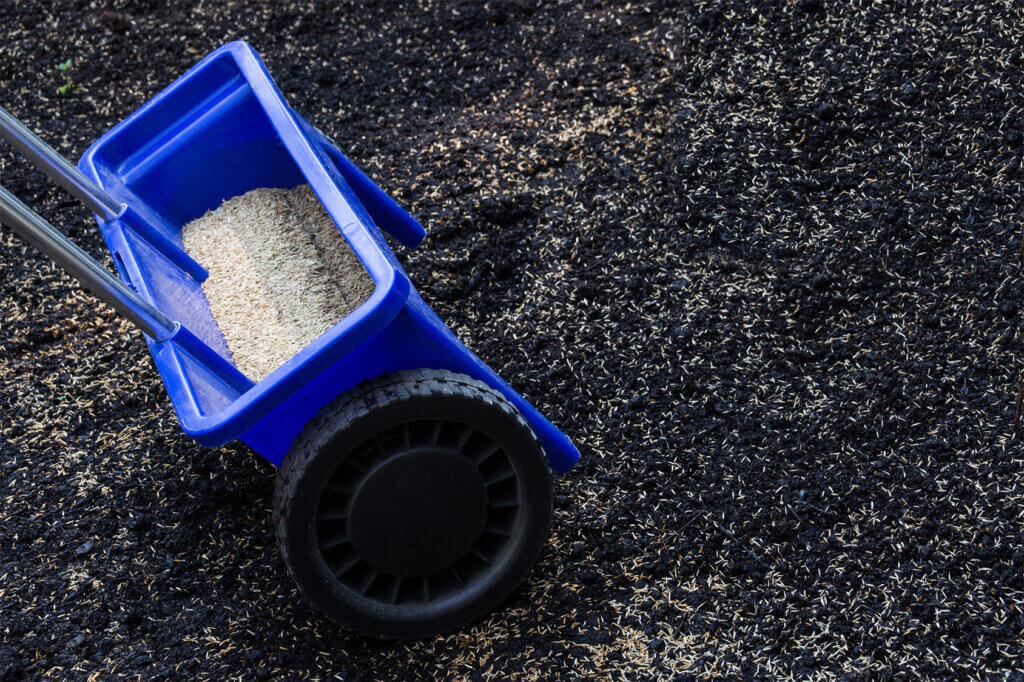
The material
Lawn spreaders can be made of different materials, for example aluminium or plastic. Both raw materials are characterised by their low weight. However, the light metal is somewhat more stable and durable. In addition, it copes better with low temperatures and UV radiation. In addition, it is easy to recycle once the unit has served you well for many years.
The tyres
Buyers also have a choice of tyres: pneumatic tyres are quieter and more stable on hard surfaces. On soil, they do not cause too much compaction. However, they are more common on large lawn spreaders but not on small hand trucks. Plastic tyres, on the other hand, are cheaper and do not require regular maintenance.
Optional functions for those who want more
The following purchase criteria are not mandatory, but increase the comfort level:
Stop function
This function allows you to use the available resources sensibly and responsibly and to reduce waste. As soon as the unit comes to a standstill, the mechanism intervenes and prevents the spreading material from escaping through the spreading openings. Only when the trolley starts moving again do the sluices open. Models without this function continue to run even when stationary.
Opening mechanism
An alternative to the stop function is the opening mechanism. Although users must operate it manually, it functions just as reliably and prevents wastage of spreading material.
Spread rate regulator
Professionals and discerning private users like to regulate the quantities of spreading material ejected. In this way, it is possible to precisely measure how much grit is to be spread on an area. This is particularly useful for winter maintenance: if the area is only slightly icy, a small amount of grit or salt is quite sufficient. An individual limit is also practical when sowing or fertilising to ensure optimum plant growth.
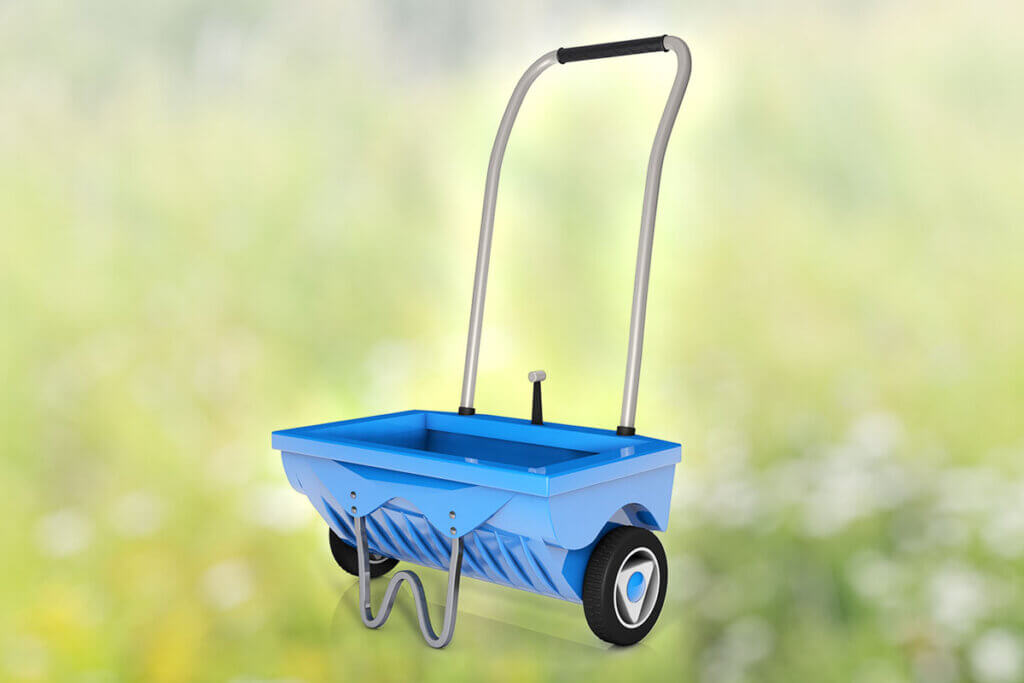
Mixing device
A mixing device offers enormous time savings. A corresponding lawn spreader is equipped with two containers in which different spreading materials are placed, for example a lawn seed and a starter fertiliser for lawns. The machine produces the desired mixture of both materials in the mixing device and spreads the mixture on the surface as usual. In this way, the lawn can be sown and fertilised at the same time in one operation, saving half the working time.
Edging
The border helps to distribute the spreading material precisely. Like a mantle, it shields certain areas so that no material gets there. There are many situations where this function pays off. A typical example is a bed along a footpath. The lawn spreader should sprinkle the pavement with salt, but not salt the sensitive plants, i.e. damage them. The border is also a good help when users want to spread a fertiliser only in one part of the garden.
Car trailer coupling
If the spreader is equipped with a car trailer coupling, it can also be towed behind a car or quad bike. This must, of course, also have a coupling facility.
How to keep the lawn spreader operational for a long time
Gritting salt and water make for a combination that causes considerable damage to many materials. Even if the road salt appears to be completely dry, it constantly attracts moisture from the environment. Some metals begin to rust under these influences. Such damage can be irreparable. So it is not enough to just put the container in the dry and then hope for the best.
Caution: Many plants are very sensitive to salt
If there is salt residue in the container to be cleaned, the waste water should not run off into flower beds. The plants absorb the salt through their roots and are then usually no longer able to regulate the water balance. In addition, animals should not drink the water.
If you want to take good care of your lawn spreader and keep it for a long time, you must clean it after use if there was salt in the container. With other spreading materials, it may also be necessary if the trolley is dirty. Cleaning is not complicated: It is sufficient to open the spreader openings wide and rinse the container with clean water. Then leave the spreader open for a while to air dry. More stubborn dirt can usually be easily removed with a brush. It is important to make sure that the paint does not come off or get scratched.
Fig. 1: © Utirolf / stock.adobe.com | Fig. 2: © Pixelot / stock.adobe.com | Fig. 3: © J.M. / stock.adobe.com

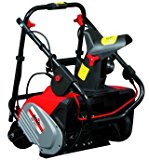
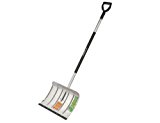

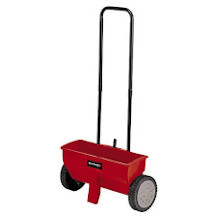
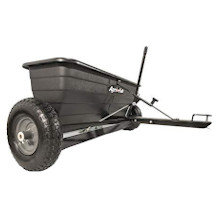
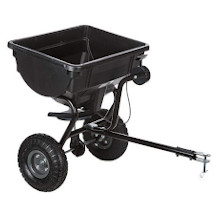
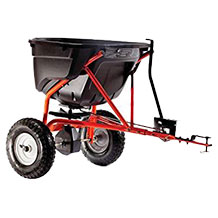
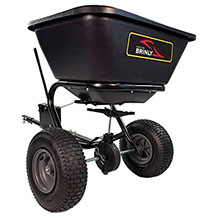

 3,162 reviews
3,162 reviews
